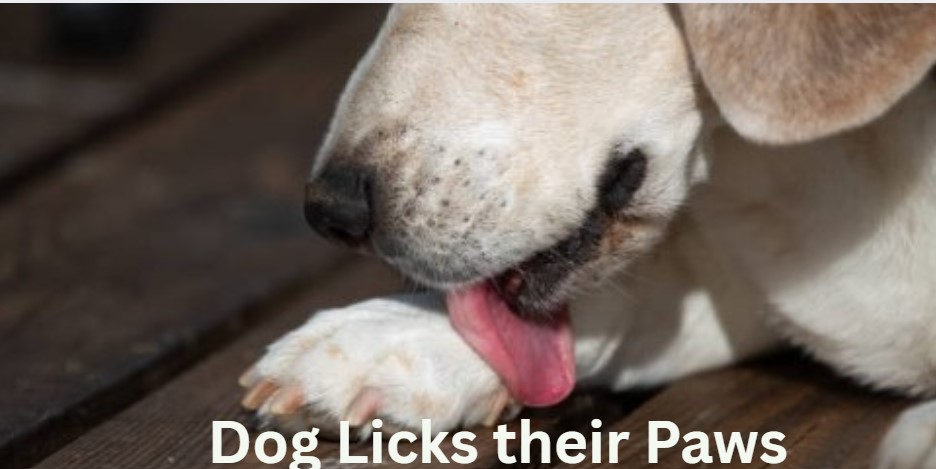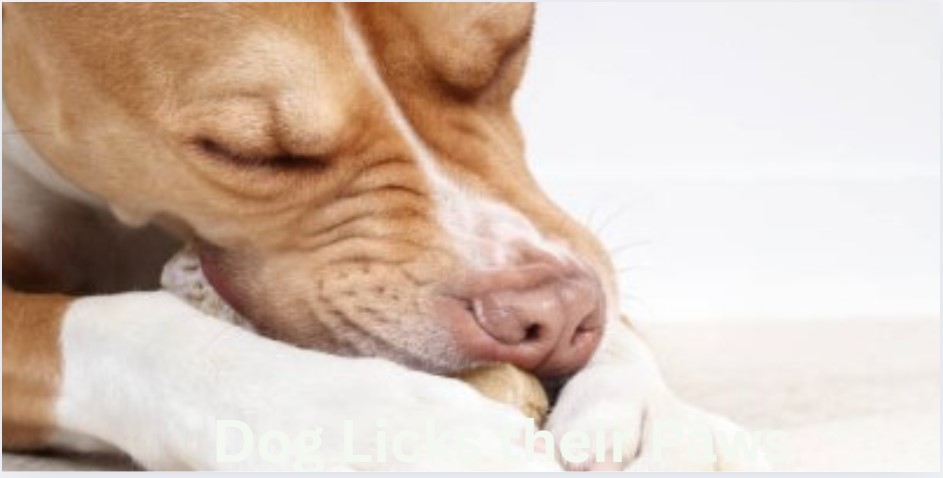When you notice your dog licking their paws, it’s often a sign of something happening beneath the surface. While dogs sometimes lick as part of their self-grooming process, frequently or intensely licking can indicate skin problems, allergies, or even anxiety. Walking on dirty or sandy ground may also lead them to clean their paws. However, if the behavior becomes excessive, it might point to more serious problems, like parasites, injuries, or even boredom. Obsessive habits often signal discomfort and require attention like a dog whining at night.
Distracting your furry friend with their favorite toy or a calming afternoon walk can help. But when licking persists, it’s time to consult a veterinarian. Experts like Valentina Henao, a medical director at Veterinary Emergency Group in Miami, emphasize that observing your pet’s quirky mannerisms can help pinpoint the causes. Whether it’s exploring new environments or addressing health concerns, timely action ensures your dog’s overall health and happiness.
Why Do Dogs Lick Their Paws- The Answer

Reasons Your Dog Is Licking Their Paws
1. Understanding Injuries and Their Role
One common reason dogs lick their paws is due to an injury. Check their toes, nails, and pads for signs of a cut, torn nail, growth, stone, thorn, or ice ball. Environmental factors like salted or hot sidewalks can lead to blisters or burns, while being stung by a bee can irritate. If your dog shows signs of limping, avoiding stairs, or decreased activity, inspect their feet for dry cracked pads, ingrown nails, or other injuries. Sometimes, muck or debris may cause discomfort, but excessive licking may need veterinarian attention. If a dog trusts you, they’re more likely to allow close inspection and care. For minor issues, first-aid treatment might suffice, but consult a professional for serious cases.
2. Understanding Dermatitis in Dogs
Causes of Dermatitis
Dogs often lick their paws due to dermatitis, a condition triggered by allergens such as grass, mold spores, dust mites, or even chemicals like those used to deice driveways. These substances in the environment can lead to an allergic reaction and cause itching, especially in areas like the face, ears, and feet.
Medications and Treatment
To manage canine dermatitis, FDA-approved options like Apoquel and Atopica are frequently prescribed. These non-steroidal medications help suppress the immune system, reducing inflammation and itching. Other treatments, including prednisone, antihistamines, and fatty acid supplements, may also be effective in controlling symptoms, though potential side effects like vomiting, diarrhea, or lethargy require close monitoring.
Infections and Topical Care
Dogs with dermatitis are prone to secondary infections caused by bacterial or yeast issues. These can be treated with antibacterial and antifungal medications, including topical treatments like medicated shampoos and conditioners. Regular bathing with lukewarm water soothes the skin, removes allergens, and helps prevent further irritation.
Diet and Veterinary Support
A hypoallergenic diet can be beneficial, especially when food allergies contribute to the condition. Working closely with a veterinarian is essential to create an effective treatment plan, addressing chronic symptoms while monitoring for any side effects or complications.

3. Food Sensitivities and Allergies
Dogs licking their paws excessively can often signal allergies or food-related issues. A vet may suggest addressing an itchy sensation caused by certain ingredients like chicken, meat, pork, or eggs or by seasonal triggers such as grass and pollen. Even household products like laundry detergents might be problematic. Persistent licking could lead to skin infections, hot spots, or ear problems, which may require topical or oral medications. To prevent worsening, a recovery cone can help, along with a tailored diet and medicated shampoos. Signs like sneezing, swollen eyes, or runny nose might hint at an underlying cause, much like how dog whimpering in sleep could suggest other discomforts. Consulting a veterinarian ensures a comprehensive approach to their care.
4. Pain or Behavior Problems
If your dog is licking their paws, they might be experiencing pain from arthritis, a foot or leg injury, or other medical conditions. Sometimes, they focus on a paw even when the discomfort is elsewhere in their body. Check for issues like a sting, cut, ingrown nail, or burn on their toes, and use a first aid kit to clean small wounds. For serious cases, seek a veterinarian’s diagnosis and treatment.
Alternatively, boredom, anxiety, or behavioral problems like OCD could be causing excessive licking. Activities like walks, playtime, or puzzle toys can boost their mental and physical energy. Stress from noises or separation can be eased with calming treats or advice from an animal behaviorist. Familiar blankets and chew items can keep them comfortable and entertained while managing these habits.
5. Arthritis in Dogs: Understanding the Cause
Arthritis is a progressive disease common in older dogs, affecting joints like hips, legs, and toes. When joint cartilage breaks, it leads to pain, inflammation, and difficulty in movement, causing discomfort in affected paws or limbs. Signs of a dog in pain include paw licking, which may help soothe their arthritic process.
To provide relief, try environmental modifications such as rugs on slippery floors, blocking access to stairs, and using orthopedic beds. Consult your veterinarian about dietary adjustments, supplements like glucosamine, or low-impact exercise to maintain mobility. Weight management reduces stress and pressure on joints, while FDA-approved medications like Librela™ or Galliprant® can ease severe symptoms, often administered by a vet or given at home.
6. Understanding Secondary Infections
Dogs often display licking behavior that can be indicative of a health problem, which, if ignored, may become harmful. When your furry friend licks their paws constantly, it creates moisture that could lead to bacterial or yeast infections. Signs like itching, redness, or swelling may develop, making the situation worse. As a dog owner, it’s crucial to recognize these symptoms and act quickly. You can use topical sprays, anti-itch solutions, or even steroids to reduce inflammation, while your veterinarian may prescribe antibiotics and antifungals to treat infections. According to the American Kennel Club, addressing these issues early prevents further complications, helping your dog stay happy and clean.
Additionally, external factors like fleas, ticks, or parasites can exacerbate paw-licking behavior. These pests may hide in bedding, carpets, toys, or even outdoor areas with tall grasses and wooded zones. Signs to look for include black spots on the skin, small moving bugs, or dirt-like flea debris. Ticks often burrow between the toes, under the legs, or behind the ears. Use tweezers or a special tick spoon to carefully remove them without leaving embedded parts behind. Preventative medication, whether prescription or over-the-counter, can offer a long-term solution. Consulting your vet will help you identify the best options to prevent and manage these challenges, ensuring your pet can focus on fun activities instead of discomfort.

7. Diagnosing atopic dermatitis in dogs
Dogs licking their paws can seem normal at first, but if it becomes excessive, it might be a sign of allergies, parasites, or even diseases like atopic dermatitis. This condition, caused by an overactive immune response, often requires careful clinical and physical examination by a veterinarian. Using their expertise, a vet will perform a thorough body exam to identify fleas, lice, or mites as potential causes. To rule out other factors, tests like blood panels, fecal tests, or urinalysis may be conducted. These tests can uncover thyroid issues or other underlying conditions that might be contributing to the paw-licking behavior.
If an allergy is suspected, your vet may recommend an elimination diet, which avoids a specific ingredient or protein your dog has previously eaten. This prescribed diet introduces new carbohydrate and protein sources to identify triggers. If the symptoms persist, allergy testing might be necessary. Intradermal testing, often considered the “gold standard,” involves clipping fur and injecting small amounts of allergens into the skin under sedation. Although it’s highly regarded, its reliability depends on the strength of the dog’s reactions. Alternatively, antibody levels can be assessed through blood testing, but this too has its pros and cons. Whichever method is chosen, your vet will discuss the costs and types of treatment to ensure the best care for your dog.
Conclusion
Excessive paw licking in dogs can signal underlying issues like allergies, dermatitis, pain, or behavioral problems. Regular monitoring, veterinary care, and preventive treatments such as paw balms and hypoallergenic diets can ensure your dog stays healthy and happy. Addressing paw licking causes early help to prevent infections and supports long-term well-being.
FAQs
Why is a dog licking her paws so much?
Dogs lick their paws as part of self-grooming, keeping them clean outdoors, at meals, or before a nap. This shows how fastidious they are, like a careful groomer. If you notice excessive licking, it might mean irritation or an issue needing attention, though it’s normal occasionally for settling
Should You Worry About Paw Licking?
Excessive licking of your dog’s paws can make them moist and lead to infections where yeast or bacteria might grow in the fur and skin. This often causes redness, swelling, itching, and discomfort, creating a dangerous cycle that leaves your pet feeling uncomfortable and unhealthy. Keep an eye on their habits to avoid serious issues.
What Does It Mean When a Dog Licks Your Feet?
Dogs often lick as a sign of affection, and when they target your feet, it might be their way of expressing love. It’s also possible that the scent from your skin interacts with their glands, creating a comforting or territorial response. While some may find it disgusting, as long as your feet are healthy, without open wounds, and free from medications like psoriasis creams, it’s generally safe and poses no harm. Dogs might also lick to explore their surroundings or communicate their feelings, using their paws and other cues to mark their territory in unique ways.
What Can I Use to Keep My Dog’s Paws Moisturized?
If your dog’s paw pads are dry or cracked, keeping them smooth and healthy is important. You can apply a paw balm or gel, which are available commercially, or try butter, vaseline jelly, or coconut oil on a regular basis. Many pet owners trust products like Musher’s Secret, a favorite among sports competitors, or Dermoscent BioBalm, which excels at repairing dry skin and managing hyperkeratosis. For harsher conditions like ice, snow, or intense heat, a beeswax-based product like Pawmagik can help protect sensitive paws.
